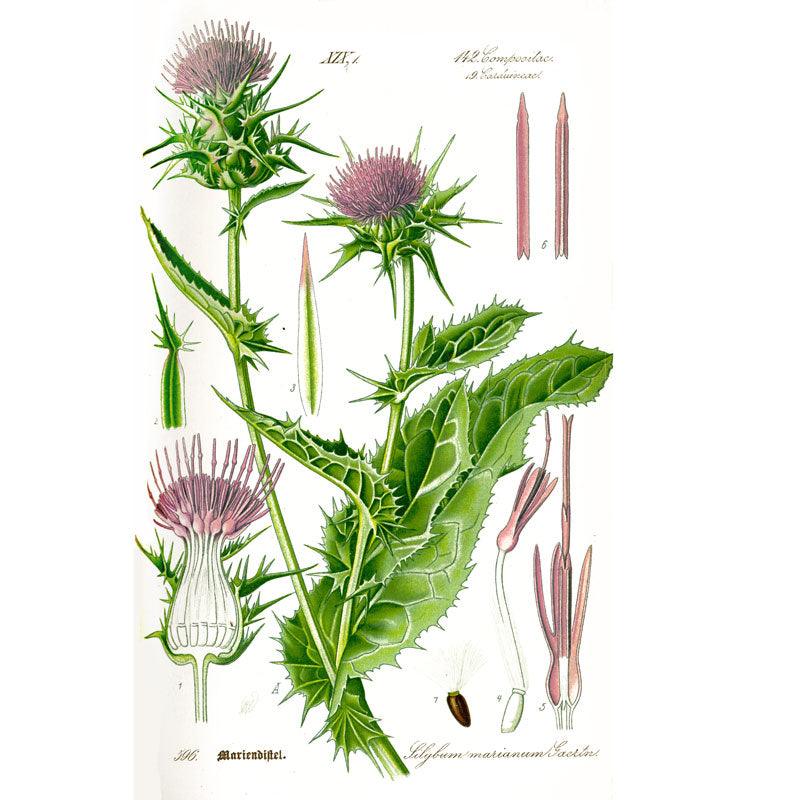Item Number: SNV7072
Milk Thistle Seeds (Organic)
Naturalizes Easily
Milk thistle (Silybum marianum) is a striking annual or overwintering annual herb, native to the Mediterranean and now widely naturalized across parts of North America. Recognized for its glossy, white-variegated leaves and bold purple flowers, this robust plant produces the nutrient-rich milk thistle seed—prized for both traditional wellness and culinary use.
Our organic milk thistle seeds grow strong, upright plants in full sun and well-drained soil, offering an excellent option for gardeners and herbalists alike. Each packet contains approximately 50 certified organic seeds.
Growing Information
- Botanical Name: Silybum marianum
- Common Name: Milk Thistle
- Life Cycle: Annual or overwintering annual
- Sun Requirements: Prefers full sun
- Soil Preference: Plant prefers well-drained soil; tolerates poor or dry soils
- Sowing Method: Direct sow in late spring or early summer; space seeds 2" apart
- Maintenance: May require staking; weed regularly to control spread
- Harvest: Collect thistle seed when flower heads dry and turn brown; hang to dry, then separate seeds
⚠️ Note: Milk thistle can be invasive. To avoid unwanted spreading, harvest seeds promptly and manage growth carefully.
Culinary and Nutritional Uses
Milk thistle seeds offer a slightly bitter, nutty flavor that adds texture and interest to many dishes:
- Roasted Snacks: Roast with oil and herbs for a crunchy, nutritious snack
- Salads & Yogurt: Sprinkle over salads or yogurt for added texture
- Baked Goods: Blend into muffins, cookies, or granola for a subtle crunch and earthy flavor
Traditional and Supplement Use
Milk thistle has been used in traditional herbal practices for centuries. Today, people are interested in its active ingredients, particularly silymarin, which is found in milk thistle extract. Studies and traditional use suggest that milk thistle may support:
- Liver function, liver diseases, or liver disorders
- Healthy blood sugar levels (related to type 2 diabetes)
- Natural breast milk production
- Cellular protection (general protective effects)
There is also ongoing research into its possible role in areas like breast cancer, but no conclusions have been approved by health authorities.
⚠️ Please Note: As with any herb, consult a healthcare provider if you have concerns about potential side effects. This product is not intended to diagnose, treat, cure, or prevent any disease. These statements have not been evaluated by the Food and Drug Administration. Milk thistle is sold as a dietary supplement, not a drug.
Why Grow Milk Thistle?
- Easy to grow and harvest from seed
- Adds bold structure and color to herb gardens
- Thrives in poor soils and dry conditions with minimal care
- A staple in traditional herb gardens with a long cultural history
Shop Organic Milk Thistle Seeds
Looking to grow your own organic milk thistle? Our certified milk thistle seed packets are ideal for gardeners, herbalists, and natural health enthusiasts.
Explore more traditional and organic herbs in our Strictly Medicinal Seeds Collection.
Photo by H. Zell




Check Your Zone Compatibility:
Compatible with your zone.
Growing Zone for

Our Guarantee To You
Since 1976, we've served our customers at every stage of growing. Please contact us at any time. We are happy to support and assist you.
Shipping Information
Shipping Information
Cannot ship to the following states: WA
Shipping Weight: 0.01 lb
Dimensions: 5.0"L x 2.625"W x 0.1"H
Features
Features
- Attracts Bees/Butterflies
- Does Not Require Support
- Open-Pollinated
- Plant Spreads
- Requires Summer Water
Characteristics
Characteristics
Planting & Care
Planting & Care
Soil & Water: Prefers full sun and regular garden soil or poor soil. Requires consistent moisture.
Planting & Growing: Sow seeds about 1/2" deep. Germination in 1 to 3 weeks. Thin plants to 3 ft apart.
Harvesting & Storage: Harvest seed heads when purple flowers dry to white fluff. Wear gloves, cut off the partially dried capitulae and drop in a bucket, further dry in the sun for a few days, then wail with a stick until the seedhead is well broken apart, and screen and wind winnow until you get pure seed.
Useful Information
Useful Information
Guarantee
Guarantee
Share






